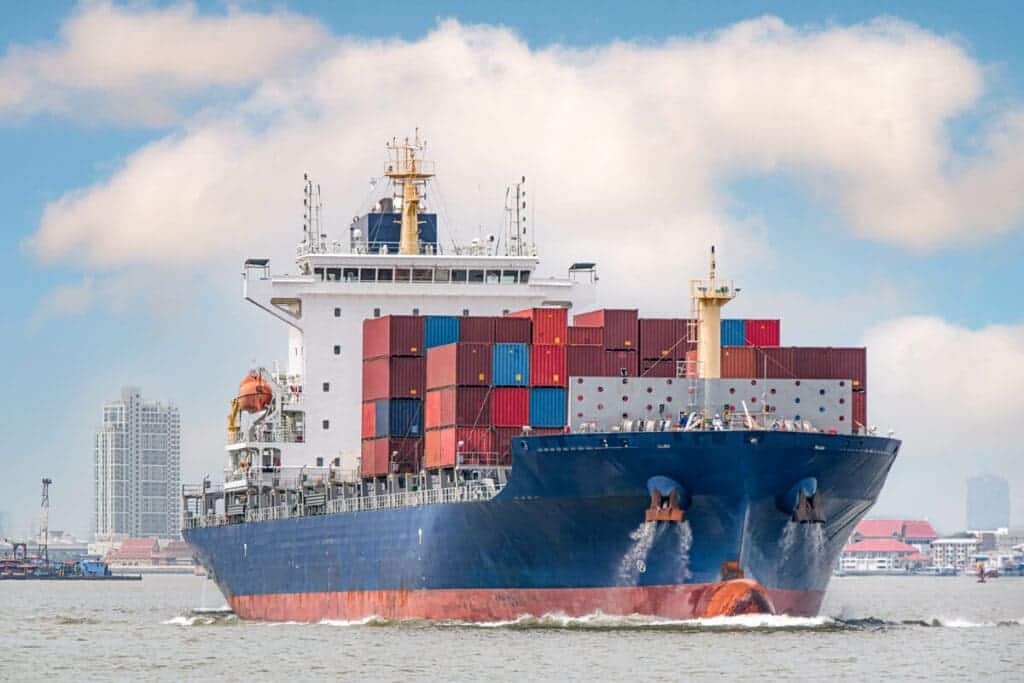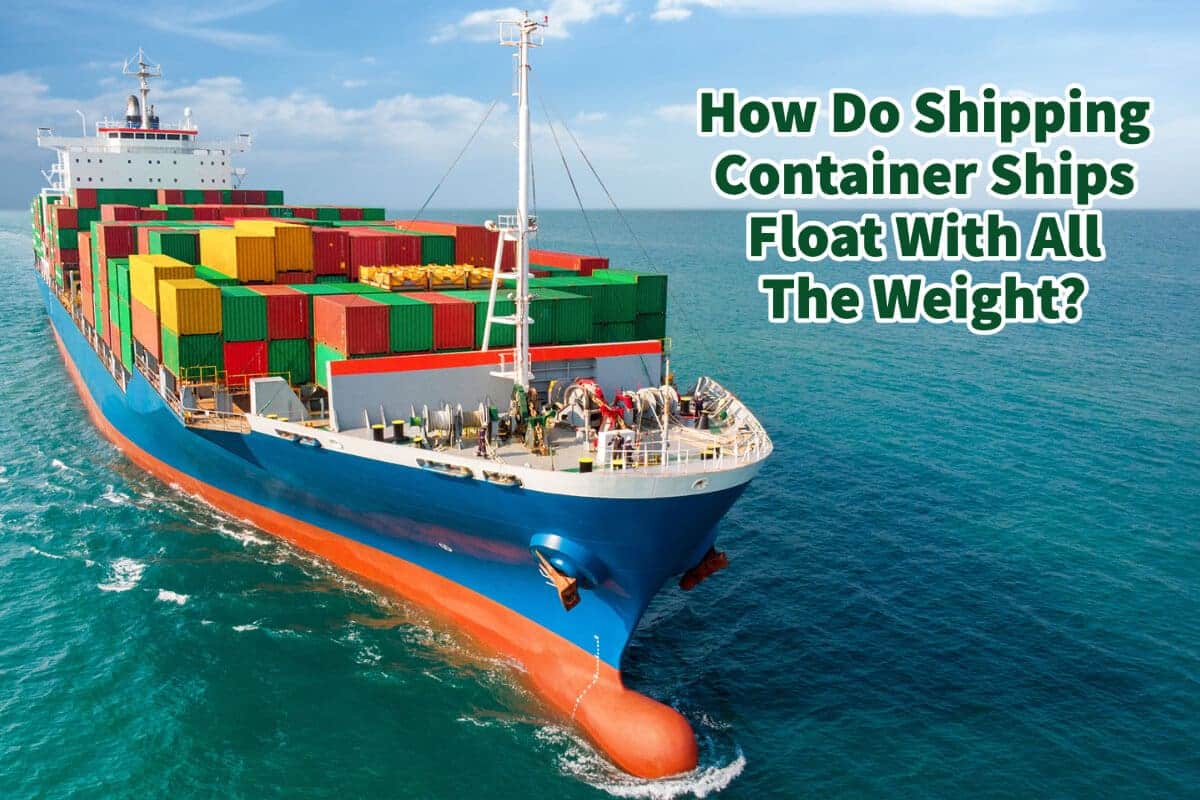Today, some container ships are so large that they are longer than four football fields. These same ships are loaded with thousands of containers filled with products.
A shipping container ship can float with all the weight of the containers because of the principles of buoyancy and flotation. Because these principles depend upon weight balance, the weight for every container is continuously checked. All the large cargo ships must also have considerable engines to cross over the world’s waterways. Some huge container cargo ships can carry over 19,000 cargo containers. To put that into perspective, if the containers were all lined up end to end, the containers for that ship would stretch over 72 miles.
Table of Contents
- Cargo Container Ships Use The Principle Of Floatation And Buoyancy
- Container Ships Have Very Powerful Engines
- A New Trend – Self-Driving Electrical Cargo Container Ships
- Frequently Asked Questions
- Related Content
Cargo Container Ships Use The Principle Of Floatation And Buoyancy
Putting a piece of iron in a bucket of water will immediately cause the iron to sink to the bottom. Yet a shipping container ship heavier than iron will be able to float over the ocean waters to carry products from location to location.

These vast, heavy ships can move across the water using the buoyancy principle. Three scientific principles explain how such a large cargo container ship can float and remain above water.
Here are the three main principles:
Cargo Container Ships And The Principle Of Buoyancy
The buoyancy principle states that an object in a liquid will have an upward force. This upward force, when it is more than gravity or the downward force, will cause the object to float by the upward pressure exerted by the liquid; this is known as a buoyancy force.
Because of this large shipping container’s buoyancy, cargo ships can float when crossing the water.
Shipping Container Ships And Archimedes Principle
Another principle that also explains this is the Archimedes principle. The Archimedes principle is that an object immersed in a liquid will experience an upward force from the liquid; the upward pressure is equal to the weight of the fluid displaced by the object. This is similar to the buoyancy principle but also talks about the weight and how the object displaces the weight.
Shipping Container Ships And The Law Of Flotation
Another law or principle is the law of flotation. The law of flotation states that materials whose density is lower than that of the liquid immersed in water will float on that liquid. An example is that both wood and oil will float on water as the density of water is higher than that of oil or wood.
When you understand all these principles, you can also understand why, when you’re shipping a container, the shipping company will check the size of the container and the weight. The container ships need to know the weight of all the cargo on their boats to ensure the container ships will float and have the proper buoyancy.
Container Ships Have Very Powerful Engines
Just being able to float or have a proper weight and buoyancy is not enough for a container ship to move across the world’s ocean waters. The engines must be big enough to carry all that heavy cargo across the water.

For some ships, the engines are so large they can be over 55 feet or 17 Meters high; this accounts for several stories high. Many of the boats will use a diesel engine. But what engine or fuel they use can depend on the ship itself.
But for the buoyancy and flotation principles to work, a cargo ship must also have an engine that is powerful enough to carry it through the water.
A New Trend – Self-Driving Electrical Cargo Container Ships
One of the trends in cargo container shipping has been self-driving all-electric cargo ships. The principles for these ships are similar to self-driving electric cars.
Many feel that self-driving cargo ships could become a thing of the future. Not only do these ships help to save on pollution if the boats are used instead of trucks to move products, but the ships also allow for less or no crew to be aboard the boat as it moves from port to port.
Many see this as the way for the future as the ships will move across the water with completely autonomous operations and a small crew onboard. Some companies pushing this have said to retrofit some of the present cargo ships as self-driving is not very expensive. We will need to see if shipping companies will start to have more of their cargo containers fully or partly self-driving.
Find out more about how Mondoro can help you create, develop, and manufacture excellent home decor and furniture products – don’t hesitate to contact me, Anita. Check out my email by clicking here or become a part of our community and join our newsletter by clicking here.
Mondoro gives out a FREE Lookbook to anyone interested. You can receive a copy of our latest Lookbook by clicking here.
Listen to our Podcast called Global Trade Gal. You can find it on all major podcast platforms. Try out listening to one of our podcasts by clicking here.
Subscribe to our Mondoro Company Limited YouTube Channel filled with great videos and information by clicking here.
Frequently Asked Questions
1. How do container ships stay afloat with the immense weight of thousands of cargo containers?
Container ships rely on the principles of buoyancy, where the weight of the water displaced by the ship is equal to the weight of the ship and its cargo. This allows them to float despite their heavy loads.
2. What is buoyancy, and how does it contribute to the ability of container ships to stay afloat?
Buoyancy is the upward force exerted by a fluid (in this case, water) that opposes the weight of an immersed object (the ship). Container ships are designed to displace enough water to generate buoyant force greater than their total weight.
3. How is the weight balance of cargo containers maintained on a container ship?
Weight distribution is crucial for maintaining balance. Ship crews carefully load containers and continuously monitor the weight distribution to ensure the ship remains stable and afloat.
4. Why is it essential for container ships to have powerful engines?
Large container ships need powerful engines to navigate through the world’s waterways and overcome the resistance caused by their size and weight. These engines are crucial for maintaining speed and maneuverability.
5. What happens if the weight distribution on a container ship is not properly managed?
Poor weight distribution can lead to instability, making the ship prone to capsizing. To prevent this, containers are strategically loaded, and their weight is continuously monitored and adjusted during the voyage.
6. How do container ships manage to carry over 19,000 cargo containers without sinking?
The design of container ships ensures that they displace enough water to support the weight of the ship and its cargo. The principles of buoyancy and flotation are carefully considered in the ship’s construction.
7. How does the size of modern container ships compare to traditional measurements like football fields?
Some contemporary container ships are longer than four football fields. This size is accommodated by their design and construction, allowing them to efficiently carry large quantities of cargo across long distances.
8. Can you explain the relationship between the length of container ships and the number of cargo containers they can carry?
Longer ships often have more space to accommodate additional containers. However, other factors, such as the ship’s width and design, also influence its cargo-carrying capacity.
9. What role do modern technologies play in ensuring the stability of container ships with heavy loads?
Advanced technologies, including computerized weight monitoring systems and navigation tools, play a vital role in maintaining the stability of container ships. These technologies help in real-time adjustments and enhance overall safety.
10. How far would the containers from a ship carrying over 19,000 cargo containers stretch if lined up end to end?
If the containers from a ship carrying over 19,000 cargo containers were lined up end to end, they would stretch over an astonishing 72 miles. This illustrates the massive scale and capacity of modern container ships.
Related Content
5 Steps To Import Home Decor And Household Decoration Items
To import home decor household decoration items, you must first understand what you will import. Home decor and household items are a huge and vast category of products. Next, you must fully understand who you will buy the products from through product sourcing.
You can learn more by reading 5 Steps To Import Home Decor And Household Decoration Items by clicking here.
An Insider Guide To Where Home Decor Stores Get Merchandise
Some of the best home decor stores we have been to will use a mix of these different buying methods. In other words, they will buy some great-looking products from wholesalers, have some products they have manufactured or sourced themselves, and then bring in some local craftsmen and sell their products. This gives the stores a unique mix and look.
To learn more, you can read An Insider Guide To Where Home Decor Stores Get Merchandise by clicking here.
Why Home Decor Matters? 10 Reasons Why Home Decor Is Important
Home Decor matters since how our home is decorated can and will affect all aspects of our lives. Our homes show the world who we are and what is important to us. Our home decor can affect our physical and mental well-being. Our homes are also gathering places for our families, friends, and loved ones.
You can discover more by reading Why Home Decor Matters? 10 Reasons Why Home Decor is Important by clicking here.

